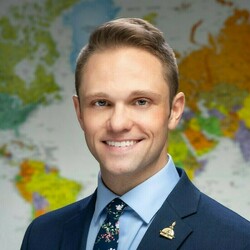
Notre Dame Global’s new name
This month, Notre Dame International rebranded itself as Notre Dame Global. I thought this was an interesting case study in the importance of word choice and intention, and I reached out to Cory Hankins, director of global communications, to learn more about the change. Read on for a Q&A about the process.
Why Global instead of International?
While the term “International” has served us well in the past, we believe “Global” suggests a more forward-looking perspective, emphasizing interconnectedness of Notre Dame’s 12 locations around the world and reflecting a broader shift in our engagement with the world. The University’s strategic framework states that “Notre Dame must be the leading global Catholic research university, on par with but distinct from the world’s best private universities,” so it makes sense that our name and messaging directly align with this mission.
What were some considerations (practical or philosophical) in enacting the change?
We felt it was important to be as collaborative as possible as we considered the myriad aspects of rebranding our division from Notre Dame International to Notre Dame Global. In October 2023 we formed a Global Rebrand Task Force comprised of NDG team members from South Bend, London, and Rome, as well as colleagues from the Keough School of Global Affairs, ND Creative, and the Office of the Provost. We engaged with a messaging expert and began the process of developing narrative verbiage meant to encapsulate Notre Dame Global’s commitment to truly being “the place where Notre Dame meets the world and the world meets Notre Dame.”

In addition to developing this verbiage, we also had to think through the process of updating our naming convention that previously used “gateway” and “center” to identify our locations. By removing these terms, we hope to focus on the impact each of our locations is creating around the world, rather than merely explaining the differences between a gateway and center. We also created several working groups that included members from all our global locations and addressed various aspects of the rebrand including social media, photography, websites, and marketing materials.
What are your hopes for the new Notre Dame Global?
We hope to play an integral role in helping the University develop and implement its global strategy. As Michael Pippenger recently said, “Notre Dame Global strives to be a steward of the University’s enduring commitment to global scholarship. We want to ensure that Notre Dame’s mission and vision extend to every corner of the world. In doing so, we come into solidarity with others, joining forces with partners to learn from one another and then work together to serve the common good.”
If people want to learn more, where should they go?
We encourage everyone to visit global.nd.edu to learn more about the work our division is doing and how it aligns with the strategic framework. As we move into Phase II of the rebrand, we will begin rebuilding each of our 16 websites, which contain more specific information about our 12 global locations, as well as our Global Engagement Programs, International Student and Scholar Affairs, and Study Abroad units.
One space or two?
One common question I get is whether to use one or two spaces between sentences.
If you learned to type on a typewriter, odds are you learned to always use two spaces. Anyone who learned to type on a computer likely learned that only one space is needed.
The reason for this comes down to legibility. Inflexible spacing on a typewriter meant that using two spaces made it easier for readers to see the separation between sentences. But in modern word processors, the computer automatically adjusts the spacing, making two spaces extraneous.
So where does the University Style Guide come down? We follow Chicago: Use only one space between sentences, in all contexts.
Pop quiz
Following University style, which of these sentences has the right capitalization?
- Father Jenkins will be the Commencement speaker in May.
- Father Jenkins will be the commencement speaker in May.
- Father Jenkins will be the Commencement Speaker in May.
A note about the pop quiz
Please think of these monthly quizzes as open-book! I don’t expect you to know the answer off the top of your head. I designed these quizzes, in fact, to get readers more comfortable using the University Style Guide to find the answer. You are encouraged to consult that before submitting your answer.
March pop quiz winner
Congrats to Heather Asiala, program director for strategic initiatives in the Office of the President, the winner of the March pop quiz!
Following University style, what’s the preferred spelling for this word? livestream
This term is recent enough that there is no widely settled style. The University prefers livestream as one word in all instances.
What we’re reading
These are stories that we found to be interesting, fun, or thought-provoking. The views are not necessarily endorsed. Want to share a story you found? Feel free to send it to me.
AP survey reveals AI’s impact on newsrooms
The Definitive Source (AP blog)
Kobe Bryant statue has multiple misspellings and now the Lakers are working to correct the typos
CBS Sports
Latest style guide updates
-
spaces
Following Chicago, use single spaces between sentences, in all contexts. Use a single space after a colon. Dashes do not have spaces around them. -
Washington, DC
Following Chicago, there are no periods in DC. Use the full name on first reference, instead of just DC or Washington.
Always add commas on both sides of DC: We’re driving to Washington, DC, tomorrow. The office is in Washington, DC.
Editor’s Note is a monthly email that goes out to anyone who communicates on the University’s behalf.
Did someone forward you this email and you’d like to get on the mailing list? Please fill out this form.